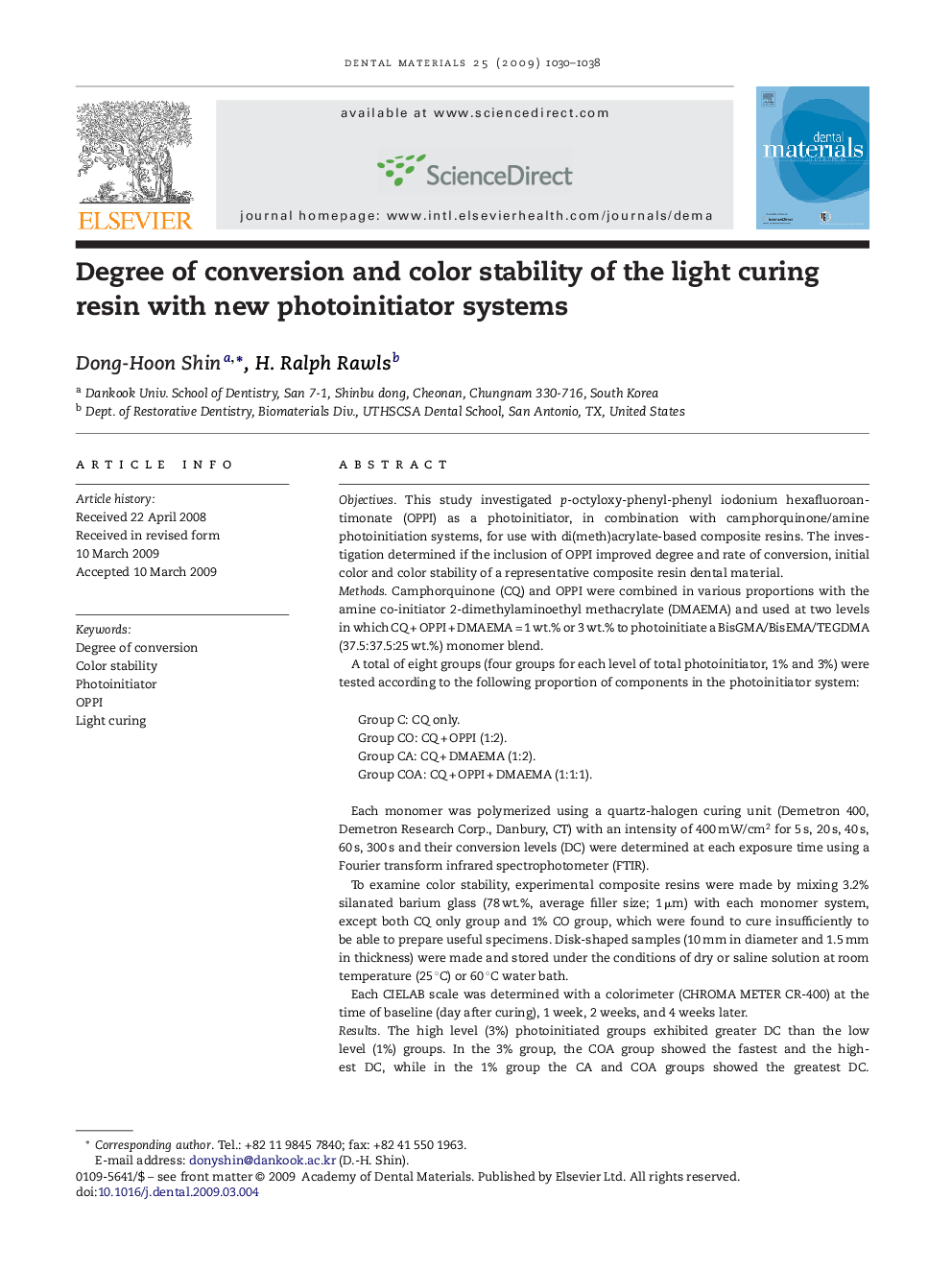| کد مقاله | کد نشریه | سال انتشار | مقاله انگلیسی | نسخه تمام متن |
|---|---|---|---|---|
| 1423058 | 986476 | 2009 | 9 صفحه PDF | دانلود رایگان |

ObjectivesThis study investigated p-octyloxy-phenyl-phenyl iodonium hexafluoroantimonate (OPPI) as a photoinitiator, in combination with camphorquinone/amine photoinitiation systems, for use with di(meth)acrylate-based composite resins. The investigation determined if the inclusion of OPPI improved degree and rate of conversion, initial color and color stability of a representative composite resin dental material.MethodsCamphorquinone (CQ) and OPPI were combined in various proportions with the amine co-initiator 2-dimethylaminoethyl methacrylate (DMAEMA) and used at two levels in which CQ + OPPI + DMAEMA = 1 wt.% or 3 wt.% to photoinitiate a BisGMA/BisEMA/TEGDMA (37.5:37.5:25 wt.%) monomer blend.A total of eight groups (four groups for each level of total photoinitiator, 1% and 3%) were tested according to the following proportion of components in the photoinitiator system:Group C: CQ only.Group CO: CQ + OPPI (1:2).Group CA: CQ + DMAEMA (1:2).Group COA: CQ + OPPI + DMAEMA (1:1:1).Each monomer was polymerized using a quartz-halogen curing unit (Demetron 400, Demetron Research Corp., Danbury, CT) with an intensity of 400 mW/cm2 for 5 s, 20 s, 40 s, 60 s, 300 s and their conversion levels (DC) were determined at each exposure time using a Fourier transform infrared spectrophotometer (FTIR).To examine color stability, experimental composite resins were made by mixing 3.2% silanated barium glass (78 wt.%, average filler size; 1 μm) with each monomer system, except both CQ only group and 1% CO group, which were found to cure insufficiently to be able to prepare useful specimens. Disk-shaped samples (10 mm in diameter and 1.5 mm in thickness) were made and stored under the conditions of dry or saline solution at room temperature (25 °C) or 60 °C water bath.Each CIELAB scale was determined with a colorimeter (CHROMA METER CR-400) at the time of baseline (day after curing), 1 week, 2 weeks, and 4 weeks later.ResultsThe high level (3%) photoinitiated groups exhibited greater DC than the low level (1%) groups. In the 3% group, the COA group showed the fastest and the highest DC, while in the 1% group the CA and COA groups showed the greatest DC.In the color stability test, both CA groups were darker and more yellow than the CO and COA groups. Color was more stable in composite resins containing OPPI than those containing only the CQ and amine components. The least color change (greatest color stability) was found using 25 °C saline solution aging, and the most change (least color stability) occurred using 60 °C dry air aging.SignificanceThis study suggests that OPPI can be used to replace the amine in a given CQ/amine photoinitiator system to accelerate cure rate, increase conversion, reduce initial color and increase color stability.
Journal: Dental Materials - Volume 25, Issue 8, August 2009, Pages 1030–1038